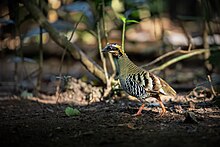Orange-necked partridge
| Orange-necked partridge | |
|---|---|

| |
| Scientific classification | |
| Domain: | Eukaryota |
| Kingdom: | Animalia |
| Phylum: | Chordata |
| Class: | Aves |
| Order: | Galliformes |
| Family: | Phasianidae |
| Genus: | Arborophila |
| Species: | A. davidi
|
| Binomial name | |
| Arborophila davidi Delacour, 1927
| |
The orange-necked partridge (Arborophila davidi) is a species of
Taxonomy
This species was described by
Description
The orange-necked partridge is about 27 cm (11 in) long and weighs about 241 g (8.5 oz). The forehead and crown are dusky, and the nape is mottled brown. A black band extends from the beak to the sides of the neck, and a whitish band extends from the eye to the neck-sides, becoming orange. There is also a black breast-band. The chin is pale buff, and the throat is rusty-orange. The breast is olive-brown, and the belly is greyish and whitish. The flanks have black and white scallops. The back and rump are olive-brown, with dark brown bars. The
Distribution and habitat
The orange-necked partridge is found in southern Vietnam and a small area in
Behaviour
Little is known about this partridge's behaviour. The territorial calls are a repeated, accelerating prruu, becoming pwi at higher pitches, and also a series of fast tu notes. In duets, the other bird responds with tchew-tchew-tchew. The alarm call is a pher or phu.[4]
Status
After its discovery in 1927, the orange-necked partridge was "lost" until its 1991 rediscovery in
In 2000, the orange-necked partridge appeared on a national stamp of Vietnam.[1]
References
- ^ . Retrieved 16 November 2021.
- ^ Delacour, J. (1927). "New Birds from Indo-China". Bulletin of the British Ornithologists' Club. 47: 169.
- ISBN 9781408133262.
- ^ ISBN 9781408135655.
- ^ a b c Le Manh Hung; Nguyen Manh Ha; Tran Thieu Du; Tran Duc Ai; Vuong Duy Lap; Vu Thanh Phong (2006). The Status and Distribution of Orange-necked Partridge Arborophila davidi in Binh Phuoc Province, Vietnam (PDF) (Report).
- ^ Nguyen, Tran Vy; Savini, Tommaso; Carroll, John P. (2014). "Defining the Present Range of the Orange-necked Partridge (Arborophila davidi) in Vietnam" (PDF). Natural History Bulletin of the Siam Society. 60: 23–30.

